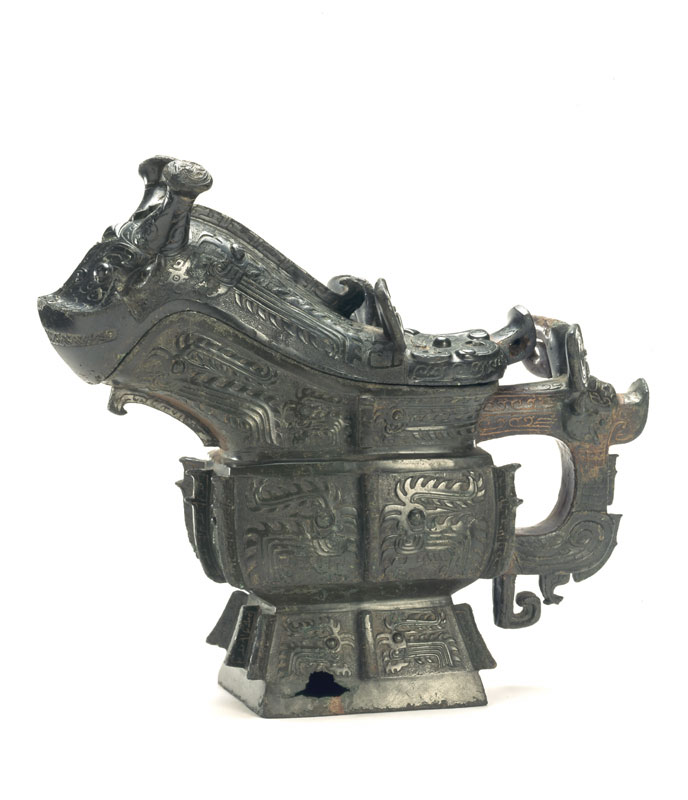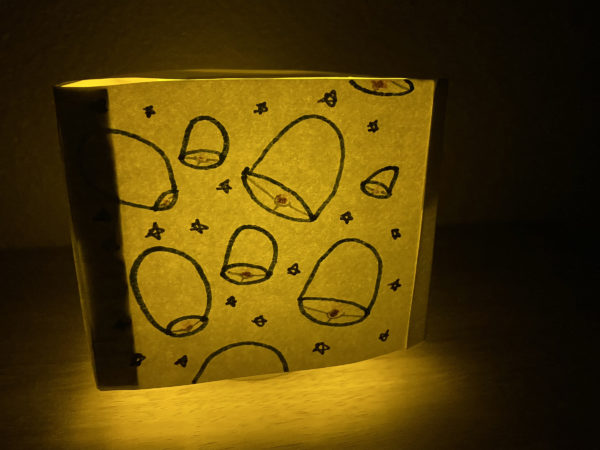A date around 1050 BCE is generally accepted as the date of the defeat of the Shang dynasty (approx. 1500 to 1050 BCE) by Wen Wang and the establishment of the Zhou. The Zhou is divided into Western and Eastern stages, with 771 BCE a critical year, when the Zhou court moved east to Luoyang.
An Introduction to the Zhou Dynasty

Covered ritual wine vessel (gong), approx. 1050-900 BCE.
A date around 1050 BCE is generally accepted as the date of the defeat of the Shang dynasty (approx. 1500 to 1050 BCE) by Wen Wang and the establishment of the Zhou. The Zhou is divided into Western and Eastern stages, with 771 BCE a critical year, when the Zhou court moved east to Luoyang.
After this point, political control is shared among a number of states during the Spring and Autumn, and Warring States period. With the Zhou, we continue to have the advantage of written histories that have been verified and elaborated on by the archaeological record. Shang records referred to the Zhou as both an enemy and an ally. Later histories reported that the Zhou settled an area between two peaks, an area today located south-west of Xian in Shaanxi province. The founder was Wen Wang, whose son, Wu Wang is credited with the defeat of the Shang. Early Zhou sites turn up at Feng and Hao, complete with chariot burials. The Zhou learned bronze making sometime around the Erligang period of the Shang dynasty. Oracle bones with inscriptions were also in use. During the Anyang period, if not before, the Zhou were already absorbing many Shang traditions and technologies. There were, however, critical differences between Shang and Zhou rule.
By the Shang, the idea that the king had a direct relationship to heaven was firmly established. The Shang worshipped Shangdi, the supreme lord who stood above the lesser gods of the elements and natural forces. The ancestors were worshipped in order to enlist their help in ensuring benevolence on the part of Shangdi. Ancestors continued to act in the world, either postively or negatively, depending on how well the king observed certain rituals. The king had a direct line to the ancestors, since he was the most direct descendent. With the Zhou, a moral dimension was added to the celestial connection. Ancestors continued to be worshipped, but the important thing was to uphold the ‘mandate of heaven.’ The Chinese histories speak of the moral depravity of the Shang rulers, particularly the last, Di Xin. This king was portrayed as the embodiment of excess and harsh rule, apparently cutting out the heart of an advisor who displeased him, torturing others, and diminishing the treasury through wine-laden orgies. Di Xin committed suicide, and the Zhou proclaimed that they were taking over the mandate of heaven from the Shang, in effect saying that the Shang had failed to minister the welfare of the people. We know that the Shang had been fighting peoples to the north, and were probably in a weakened position already, but the appeal to moral responsibility probably won over some of the Zhou’s allies in helping to defeat the Shang. Even in defeating the Shang, Wu left one son of the ruling Shang family alive to continue offering sacrifices to his family ancestors, so as not to incur the wrath of the ancestors of the defeated dynasty. This idea of the moral ruler or dynasty would be debated for some time to follow, and the (early) Zhou would be held as an example of statehood for future generations.
The Zhou inherited a vast network of city states and regions, controlling areas as far north as present-day Beijing and as far east as Shandong province. Initially, relatives of the Zhou kings were dispensed to various states to exercise control. A feudal system developed, with kings rewarding loyal subjects through a network of fiefdoms, in return for military aid and political allegiance. This structure may have contributed to a sense of civilization being contained within a central corridor, around which barbarian forces threatend. The Zhou had names for non-Zhou people in each of the cardinal directions. To the east were the Yi, to the west the Rong, to the south the Man and the north, the Di. New kingdoms began to emerge during the Zhou–the Yue to the east, and to the south, the Wu and the Chu. The peoples south of the Yangzi, according to Zhou records, tatooed themselves and cut off their hair. The notion of barbarian became even more entrenched in the idea of what constituted Chinese-ness when the Qian Rong invaded the western capital in 771 BCE. The Zhou king was killed, but his son, fled to Luoyang and reestablished the capital there.
The terms–Spring and Autumn Period and Warring States Period– are two different time periods that begin with the Zhou move to the Eastern capital at Luoyang. During these periods, the Zhou practice of delegating power to regional lords weakened Zhou influence, to the point where it held only puppet status. The real power was gradually transferring to new kingdoms such as Jin to the north –initially a strong ally of the Zhou, to the Chu kingdom expanding in the south, and later in the west, to the Qin.
The Spring and Autumn periods saw many states and territories enter into alliances with one other. A brief period of peace was led by the Duke Huan of Qi (a kingdom in the northeast) who arranged a league of states that sent tribute to the Zhou king around 656 BCE. By the Warring States period however, as the title implies, the major states were at war bronzes and other objects from this time period.
Warfare changed during this time as well. During the Shang, battles were limited in scale and duration, compared to the large numbers of soldiers mobilized during the Warring States period. The advent of double edged swords and the crossbow deemphasized the dominance of the chariot, and increased the size of the infantry. Some chivalry was still observed, but the scale of battle meant that casualties ran high, and victors (such as the Qin army) were sometimes merciless in their treatment of defeated armies. Even worse was the plight of peasants, who made up the bulk of the infantry. Even if spared after defeat, their life might become one of slavery to an alien ruler.
Despite much political uncertainty during the Eastern Zhou, this was a time of economic expansion. In the south, irrigation canals extended the development of more rice paddies. Iron tools began to be used by more people, resulting in better agricultural production. The population expanded and commercial trade increased. Bronze coins began to be minted, allowing merchants to cross contested borders without the burden of silks, cowries and other former mediums of exchange.







